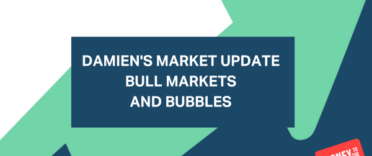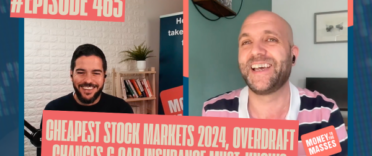The 143rd episode of my weekly YouTube show where I discuss what is happening in investment markets and what to look out for. This week I explain the latest impact the Ukraine war is having on investment markets.
Each show lasts between 5-10 minutes and is aimed at DIY investors (including novices) seeking contemporary analysis to help them understand how investment markets work.
Subscribe to my YouTube channel to receive my weekly analysis of investment markets or alternatively, you can listen via my weekly Midweek Markets podcast below.
Midweek Markets weekly podcast
Other ways to watch, listen and subscribe
You can listen to other episodes and subscribe to the show by searching 'Money to the Masses' on Spotify or by using the following links:
Abridged transcript - Midweek Markets episode 143
It certainly isn’t a boring time to be investing, with this week seeing a number of historic market moves. Perhaps it's only apt that it is 22 years to the day since the Dot-com bubble peaked. Just like then, there is a feeling that this week we are experiencing historic moments in the making in investment markets.
Firstly commodity markets had their sharpest weekly rise on record (that’s going back more than 50 years). Natural gas prices also hit a new record high while the price of a barrel of Brent crude oil hit levels not seen since 2008, principally a result of a ban on Russian oil imports by the UK and the US. The price of a barrel of Brent Crude touched $139 - before pulling back after it became clear that Europe was unlikely to join in the embargo on Russian oil
But the historic moves in commodity markets spooked equity markets at the start of the week, especially in Europe and in particular in Germany which has a heavy reliance on Russian energy. At the start of the week, the German DAX officially entered bear market territory meaning that it had fallen 20% from its recent high on 5th January. The move was repeated across European equities. But more broadly risk assets were a sea of red wherever you looked.
But in a sign of just how broken markets seem to be right now, bonds continue to be seen as a risk asset rather than their traditional status as a haven asset due to the backdrop of inflationary concerns, which have been fuelled by the meteoric rise in commodity prices this week. To give you an example of just how much prices have risen the average family car in the UK will now cost around £90 to fill. Combined with rising fuel bills and supermarket prices (as commodity prices remain elevated) consumers are feeling the squeeze. The concern is that central banks will be forced to raise interest rates in this environment in an attempt to control inflation, but at the same time risk sending economies, particularly in Europe into recession. Take the 10 year US treasury yield as an example, it has risen from 1.688% to 1.955% this week. That means bonds have tumbled in value despite the recessionary risks. Inflation is what investors are most worried about.
Gold is therefore playing the main role as a haven asset alongside the US dollar. The price of gold exploded 4% higher on Tuesday, hitting an all-time high in dollar terms of $2078 per ounce. The moves are thanks to the perfect storm of inflation pressures, geopolitics, investor fear and falling real yields. These are exceptional market moves but market sentiment can change in an instant. On Thursday news that the oil supply from the Middle East may be increased along with hopes of a dovish pivot from the European Central Bank when it announces its latest policy decision today, plus rumours that the European Union may issue joint bond sales in order to fund energy and defence spending put a rocket under European equity markets yesterday. The idea of huge fiscal and monetary stimulus to combat the economic impacts of the war, plus a plunge in the price of oil, sent the Euro Stoxx 50 up 7.4% on Wednesday, while the German DAX rallied almost 8% on the day. Meanwhile, commodity prices slumped, along with the price of gold (which fell back towards $2,000 per ounce). Analysts went scrambling for the history books to see if there had ever been such a powerful move in a single day. It led to greater calls that the bottom of the equity market is now in.
At the end of last week’s note, I wrote that there were signs of bullish divergence between the Relative Strength Index on the S&P 500 and the index itself. To understand what I mean by this listen to Money to the Masses podcast episode 348. Interestingly this continues to be the case. But at the same time, a death cross looks likely to be formed in the coming days between its 50-day moving average and 200-day moving average, something the Nasdaq 100 achieved last week. The bulls will want to capture 4300 if they are to build on the positive momentum over the last 24 hours, the S&P 500 currently sits at 4277. For European equities, much depends on what the ECB and EU announce. If they disappoint then the market could turn right back around. Nearly all equity markets are still below their 200 day moving averages, which is not a good look. From a technical analysis perspective, there is not yet too much to cheer about, especially with the German DAX, despite the near 8% rally yesterday. To give you some context, the DAX is still down for the week.
It’s a difficult market right now and the traditional bond/equity portfolio is continuing to get hurt. Those who have diversified into gold, commodities and energy stocks are faring better, for now anyway. But everything could change in a blink of an eye. The ECB is the first central bank to meet after the start of the war in Ukraine so it will be interesting to see what is announced. The US Federal Reserve and the Bank of England announce their latest policy decisions next week. These are likely to take on even more importance than usual in determining the future direction of equity markets.




